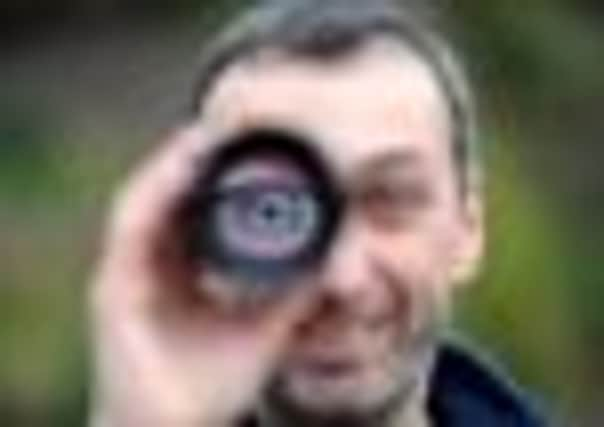Alt Photo Festival: Life through a Lens


Anyone buying a camera these days won’t be asking about film stock or shutter speed but checking out the megapixel count, the amount of memory and whether it has dozens of different features to play with.
But for a growing band of photographers in Edinburgh, low-tech is the new hi-tech and they are going back to basics to help them produce some unique and stunning images.
Advertisement
Hide AdAdvertisement
Hide AdNext week, the Alt Photo Festival opens in the Capital, showcasing the work of 18 alternative photographers across four different venues.
Building on the success of last year’s inaugural Pinhole Photography Festival, the series of exhibitions are designed to highlight the work of local photographers whilst demonstrating stripped-back photography.
Professional photographer Kenny Bean, who is behind the festival, says: “It’s all traditional processes. We are looking at hands-on stuff we do at home, with home-made cameras and developing processes with chemicals.
“Some of the photographers taking part in the festival I haven’t met yet but I really like their work.
“The festival is about showcasing photographers who are already doing great work in Scotland.
“We have lots of photography going on under the surface, but there’s not really a focus point in Edinburgh to come together.”
Kenny, 48, who has worked in the industry for 25 years, believes it is important to take a step back from the digital age and look at the basic principles of photography.
He makes his own cameras from something as simple as a tin box, and also uses “props” such as wheelie bins to capture images simply by using light and paper.
Advertisement
Hide AdAdvertisement
Hide AdHe says: “My photography is usually about using objects I can make cameras out of. I made a sun camera this year which uses no chemicals, just light and light sensitive paper.
“It takes 20 minutes to make an image in the sun, so it’s not a great Scottish camera.
“It’s very simple to make. You get a piece of photographic paper, stick it inside a tin that closes, with a hole in the front of the tin.
“I use a magnifying glass on the front of the tin to focus the paper, take it to where I want to photograph, open it up and leave it for 20 minutes until it burns an image on to the paper.”
Due to the delicate nature of the equipment and technique, the end product is something which Kenny cannot predict, which adds to the excitement.
It takes him back to the days of the dark room, which he describes as being like “alchemy and magic”.
“The pace of it is slower,” he says. “The thoughtfulness when you’re using film cameras made out of wooden boxes and the processes itself are a lot longer.
“You treasure this kind of photography a bit more because it’s harder to do and you’re more involved with it as it’s totally immersive.
Advertisement
Hide AdAdvertisement
Hide Ad“The thing about working in a dark room is about alchemy and magic when that image starts to appear.
“It takes me an hour to make a picture, rather then two seconds. Digital photography is quite throwaway. You take a picture and it’s one of thousands.”
Running alongside the exhibitions – in the Royal Botanic Garden, Edinburgh College of Art, Stills Gallery in Cockburn Street and Tidalfire in St Mary’s Street – are a series of workshops to get budding snappers involved in alternative photography.
Daily tinbox workshops are being held at the Botanics to teach people all about the darkroom process, with children aged ten and over welcome to take part.
Workshops in creating plant shadowgrams – images made without the use of a camera – will form part of the festival, while the techniques of colour pinhole photography will also be taught during workshops.
Contemporary artist and snapper Alastair Cook will be exhibiting his portrait images created through a process called wet plate collodion, a technique which dates back to 1851.
Alastair, from Leith, takes his dark room on location and develops the photos instantly, meaning his subjects become immersed in the process.
“The key is you start with a blank plate and you make the chemicals and make the photo,” he says. “It takes about ten minutes but you need to have the dark room with you.
Advertisement
Hide AdAdvertisement
Hide Ad“It works very well for portraiture because it involves the subject. For the first ten minutes they are watching you work and there’s a ‘wow’ moment at the end when the image appears. The wonderful thing about portraiture is that your subject becomes part of it.”
Alastair, 41, adds: “Last summer I did a residency in Dunbar and concentrated on the fishing community so I set up a dark room in the building beside where I was taking the photographs.
“All these old-fashioned techniques are not dying techniques. They are very much alive, but they are just not widely used anymore.
“This should never just be viewed as old stuff. It’s actually really forward-thinking – you have to be in order to do things that are original.”
Alastair’s work will be on display in the Fletcher Building at the Royal Botanic Garden.
The Alt Photo Festival runs from February 28 to March 12.
• For more details and a full list of workshops, visit www.kennybean500.webspace.virginmedia.com/altphoto/